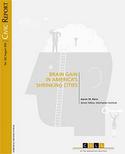The six transit legacy cities - mostly urban cores that grew largely before the advent of the automobile - increased their concentration of transit work trips to 57.9% of the national transit commuting, according to the 2018 American Community Survey. At the same time, working at home strengthened its position as the nation’s third leading mode of work access, with transit falling to fourth. The transit commuting market share dropped from 5.0% in 2017 to 4.9% in 2018. read more »
Pittsburgh
Of Niche Markets and Broad Markets: Commuting in the US
- Login to post comments
Population Transformation in Pittsburgh and Chicago
Out of the 53 metro areas with more than a million people, only four lost population last year. The two biggest losers were Pittsburgh and Chicago.
Both cities are ones where a significant cadre of local boosters brush off population loss, arguing that a closer look shows that they actually are undergoing a demographic transition that is actually putting them in a stronger position. So let’s take a look. read more »
- Login to post comments
Black Homes Matter: The Fate of Affordable Housing in Pittsburgh
“I live here. I’m from here. My whole family is here. We try to stay close together. This is America. I’m a Marine, I went to war three times. I served my country. It feels crazy not to be able to live in my own area where I grew up,” writes an East Liberty resident in Black Homes Matter, a booklet describing alternative approaches to neighborhood revitalization in the city of Pittsburgh. read more »
- Login to post comments
Family Friendly Cities
One of the common criticisms leveled at people who promote urban living goes something like this. “Cities are great for college kids, people starting off in their careers, bohemians, and maybe some older empty nesters with money who have a taste for theater and art. But most people have families and tight budgets. Suburbia is the only place that provides a high quality, safe, affordable life for regular folks with children.” read more »
- Login to post comments
America’s Shrinking Cities Are Gaining Brains
If there’s one thing that’s a nearly universal anxiety among cities, it’s brain drain, or the loss of educated residents to other places. I’ve written about this many times over the years, critiquing the way it is normally conceived.
Since brain drain seems to be a major concern in shrinking cities, I decided to take a look at the facts around brains in those places. Looking at the 28 metro areas among the 100 largest that had objective measures of shrinkage – in population and/or jobs – between 2000 and 2013, I looked what what happened to their educational attainment levels. read more »
- Login to post comments
Super Bowl XLV: The $10 Billion Bag of Chips
I am raining on the big parade by equating the Super Bowl with trade deficits, budget shortfalls, state bonds on the edge of default, and unemployment close to ten percent. But if thirty-second ads that cost $2.7 million or The Black Eyed Peas at halftime can’t lift the economy out of its doldrums, how can we expect the same miracles from Troy Polamalu or Aaron Rodgers? read more »
Forged in Pittsburgh: The Football Industry & The Steelers
When will the Labor Department come up with a statistic (GEP or Gross Entertainment Product) to measure to extent to which the economy is dependent on fun? The Pittsburgh Steelers are, at the very least, the emotional heart of Pittsburgh. In season on Sundays, the faithful wear their jerseys to church, and the city takes a reverential pause during the games, as it did during last Sunday’s AFC championship competition. Football wins in Pittsburgh are best understood as divine rapture, delivered by Steelers quarterback Ben Roethlisberger, despite his pre-season time in purgatory. read more »
Is Pennsylvania History?
On a recent whirlwind through Pennsylvania, I thought of James Carville, who popularized the notion that “It's Philadelphia on one side, Pittsburgh on the other, and Alabama in the middle.” It’s a clever line, but between the Ohio and Delaware rivers he is missing a great American tapestry: the wreck of the Penn-Central, United flight 93’s final frantic moments, the social history of the Johnstown flood, and whether a state of steel and coal is past or present. read more »




















